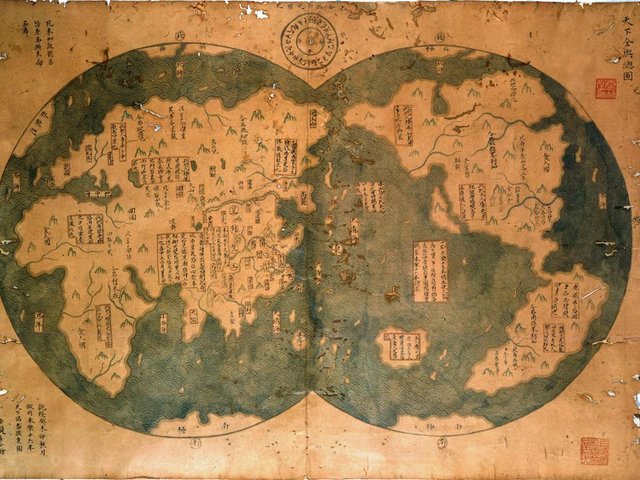Did China discover America ?
This map claims that a Chinese Muslim beat Columbus to it. But is it real?

In 1405 a Chinese Muslim eunuch, Zheng He, launched the first of seven voyages west from China across the Indian Ocean. Over the next 30 years, in command of the world’s largest fleet and funded by the Ming emperor, he sailed to the east coast of Africa and deep into the Persian Gulf. That much, we know, is true.But some people believe he went much farther—and this map is one reason. Entitled “General chart of the integrated world”, it is apparently an 18th-century copy of a 1418 map which claims to show the world that Zheng He discovered. If it is real, it rewrites history, for it shows that he circumnavigated the globe and—most provocatively—that he discovered America more than 70 years before Columbus.The map came to light in 2001 when a Shanghai lawyer, Liu Gang, says he bought it from a local dealer for around $500. He believes it proves that Zheng navigated the waters around both poles, the Americas, the Mediterranean and Australia too. In 2003 Gavin Menzies used it as evidence for his book “1421: the year China discovered the world”.The outlines of the continents on the map are instantly recognisable. Some aspects are characteristically Chinese: the blue, fan-like waves are part of China’s cartographic tradition, as are the annotations with textual descriptions of places. The map is impressively detailed. It shows the two hemispheres of the world, a convention for depicting the round Earth on flat paper. The contours of North and South America are clear, as are the rivers running from far inland. We can see the Arctic. And the Himalayas, among whose foothills Zheng He was born, are marked as the highest mountain range in the world.
It is these detailed elements, however, that give the game away. Only Europeans represented the globe this way. European explorers completed travels like this over the course of hundreds of years, rather than Zheng He’s 30, which makes it almost impossible that his maritime voyage would have had such a specific grasp of river courses. The Arctic appears first on a Ming Chinese map only in 1593. And the world’s greatest mountain range was labelled as such only in the 19th century.“This map is a complete nonsense,” says Professor Timothy Brook of the University of British Columbia. He believes that what you see here is a copy of a European map from the early 17th century. But it is still interesting, because of the stories attached to it and the recent hype surrounding Zheng He. He was certainly a great mariner, but had been largely forgotten until the late 1990s when the history of his quest was resurrected and he was embraced as a national hero. As Brook puts it: “The West had a Columbus and the Chinese needed one.”The debate over the veracity of this map is emblematic of the current arguments over China’s role on the world stage. President Xi Jinping hails Zheng He as one of China’s great innovators and an example of its early, peaceful exchanges overseas. Though he does not claim that Zheng He found America, he holds up his voyages as an inspiration for a new maritime silk road that is now being promoted to expand Chinese trade and influence abroad.Though Columbus and Zheng He both sailed the seas, their purposes were quite different. Columbus’s mission was commercial, Zheng He’s diplomatic: he was sent to bring back envoys from other countries to pay homage to the new Yongle emperor, who had usurped power from his nephew and needed to find a way to assert his legitimacy.With the end of Zheng He’s life, China’s explorations on the high seas finished too. By this time there was a new emperor with less need to finance pricey expeditions. For the next few hundred years China largely turned in on itself. What would have happened if the Chinese fleet had been allowed to continue is one of the great counterfactuals of history. Instead, while Columbus forged his way to the New World, Zheng He died a quiet death—at sea or at home, it is not known—and few beyond China now know his name. ~
ROSIE BLAU
Source: https://www.1843magazine.com/content/places/rosie-blau/rewriting-history-map?fsrc=scn/fb/te/bl/ed/
For those interested: https://en.wikipedia.org/wiki/Zheng_He
I upvoted you.